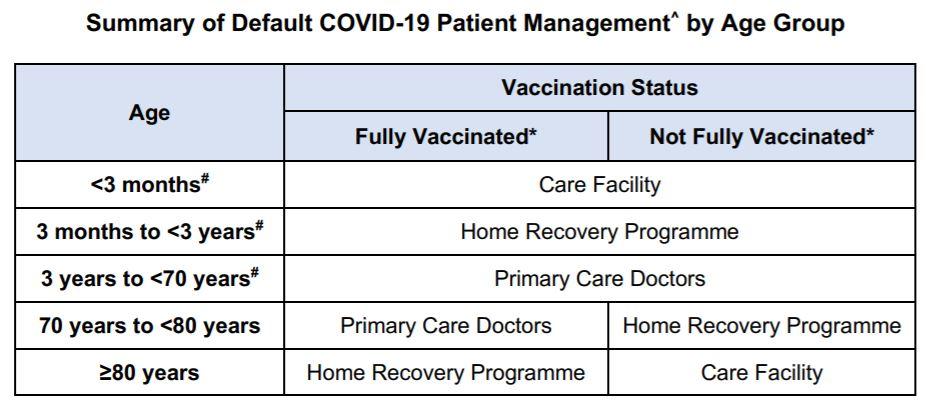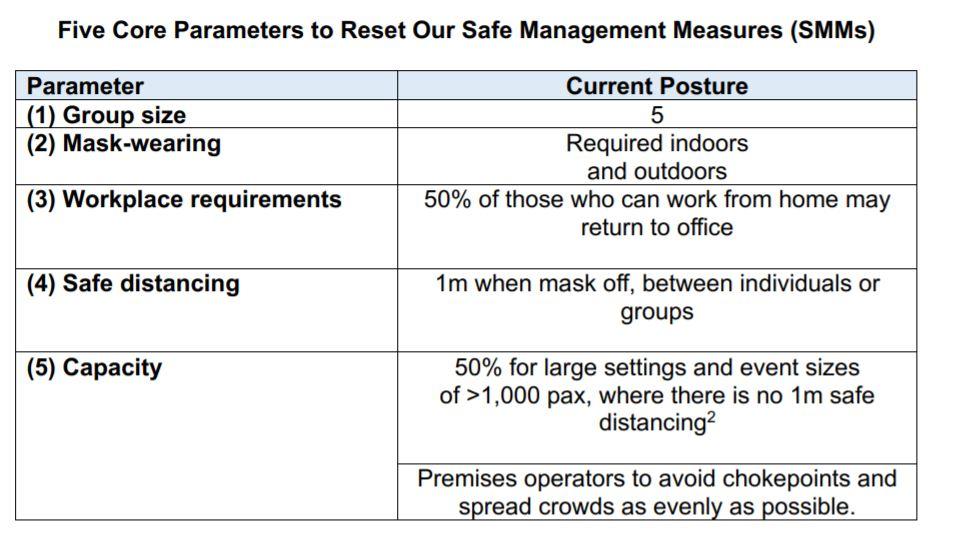share on
閱讀中文版本
Each household will be able to entertain five persons at any one time (instead of per day), while safe distancing will not be required between individuals or groups in all mask-on settings.
Singapore's Multi-Ministry Task Force (MTF) has taken big steps to reset, and simplify local COVID-19 protocols as part of the approach to live with the Omicron variant.
This comes as the nation deals with an Omicron wave that's seeing up to about 20,000 daily cases, which remains "within our expectations, given the high transmissibility of Omicron," as shared by the Ministry of Health (MOH). In the coming weeks, the Ministry does expect daily case numbers to rise even further before peaking, and these may remain moderately high for some time before coming down.
The MTF's new measures are detailed below.
1. In-person visits to hospitals and residential care homes remain disallowed
In-person visits to all hospital wards and residential care homes have been suspended till 20 February 2022 - and the latest update sees this suspension extended for a further four weeks to 20 March 2022 (inclusive), with a mid-point review after two weeks. During this period, hospitals, and homes are expected to continue with alternative methods of communication such as telephone or video calls.
Hospitals, and homes do have the discretion to allow visits for exceptional cases (e.g. if the patient or resident is critically ill or for birthing mothers), in which case these visitors will be subject to specific visitor management measures such as a valid negative antigen rapid test (ART) result obtained within the last 24 hours of the visit.
2. On-site recovery for asymptomatic or mildly symptomatic nursing home residents
Previously, nursing home residents infected with COVID-19 were moved from the nursing homes to recover at separate care facilities.
However, since the majority of these cases have been mildly symptomatic, and to avoid moving them away from a familiar environment, effective 16 February 2022, nursing homes are able to care for their fully vaccinated COVID-19 residents who are asymptomatic or mildly symptomatic within their premises, but isolated from the other uninfected residents.
Residents assessed to be at higher risk, or who show signs of clinical deterioration, will continue to be conveyed to an appropriate care facility for further management.
3. Recovery 'Protocol 2' expanded to include more patients
With the vast majority from most age groups infected since January 2022 having had mild symptoms and being able to recover safely on their own, effective 16 February 2022:
- All patients aged three to 69 years, regardless of vaccination status, and
- Fully vaccinated patients aged 70 to 79 years old, can be managed by their primary care doctors under 'Protocol 2'.
What that implies is that more age bands can be eligible for the Home Recovery Programme.
Patients falling outside of these age brackets will continue to be managed by MOH, either through the Home Recovery Programme or at a care facility such as a COVID-19 treatment facility or a hospital.

As such, individuals under Protocol 2 with non-emergency conditions, including children, are strongly advised to avoid seeking treatment at the EDs of hospitals, and to consult their primary care doctors or telemedicine providers instead.
Those with non-emergency conditions turning up at EDs may be diverted to other urgent care clinics for further assessment, or may be diverted for admission to COVID-19 treatment facilities for further monitoring of their medical condition, as long as they do not require hospitalisation.
4. Recovery 'Protocol 3' relaxed in two ways
Protocol 3 has been updated in two ways, effective 18 February 2022:
It will be changed from an order to an advisory. This means the Health Risk Warning (HRW) will be replaced with the Health Risk Notice (HRN) for close contacts of COVID-positive patients. As such, those issued with HRN can continue to obtain their ART test kits through designated vending machines. Exceptions - For the healthcare, eldercare, and preschool sectors, additional requirements may be put in place for close contacts.
Second, the recommended self-monitoring period will be reduced from seven days to five days, as individuals infected with the Omicron variant have been shown to have a shorter incubation period. Exceptions - Those who have already received HRWs prior to 18 February 2022 should still complete their existing monitoring periods.
Regardless of whether one receives an HRN or not, MOH has urged all persons who are aware of their recent exposure to a case to:
- Moderate their social activities,
- Monitor their health, and
- Self-test with ART before leaving home for that day, especially if they are going to crowded places or are coming into contact with vulnerable individuals.
5. Streamlining of the rostered routine testing (RRT) regime to focus on specific settings
From 18 February 2022, the RRT regime will be streamlined to focus only on settings catering to vulnerable groups (i.e. healthcare sector, eldercare sector, and settings with children below five years old, and selected essential services sectors. Other sectors which are currently on RRT will no longer be required to continue testing.
Read all about the changes to the RRT regime, and what that means for employers & the self-employed here.
6. Community measures: Changes to household visitors and safe distancing
The changes to the community safe management measures are provided in the below snapshot, and for further details, scroll past the image:

Community safe management measures are detailed below:
- Group sizes: The permissible group size for social gatherings remains at five persons.
- Household visitors: The maximum number of unique visitors per household will be increased from five persons per day, to five persons at any one time.
- Mask-wearing: Mask-wearing will continue to be required as a default. There are no new exceptions.
- Workplace requirements: The current status of allowing 50% of work-from-home employees to return to the office will remain in place. However, several areas have opened up for employers. Click here to read all the new rules to stay on top of.
- Safe distancing (mask-on vs mask-off settings): Safe distancing is encouraged but will not be required between individuals or groups in all mask-on settings. Safe distancing will continue to be required for all mask-off settings. The safe distance required will be streamlined to one metre for all settings.
- Capacity limits: Event sizes will be set based on the capacity of the venue. Hence, from 4 March 2022, specific event size limits for events such as religious services, business events, media conferences, funerary memorial events, wedding receptions, and mask-on classes will be removed.
- However, capacity limits will be imposed for large events which pose more infection risks (such MICE and large work-related events). Click here to read all the new rules to stay on top of.
- Vaccination-differentiated measures (VDS): From 25 February 2022, unvaccinated children aged 12 years and below (i.e. born in 2010 or later) need not be from the same household to be included within a group entering premises or participating in activities with VDS.
7. Sports activities to proceed for up to 30 vaccinated persons
Effective 25 February 2022, all sports will be allowed to proceed with up to 30 fully vaccinated persons (including players, coaches, umpires, etc.), at supervised/operated sports facilities (e.g. ActiveSG facilities and approved private facilities). The prevailing SMMs will apply before, and after the sport activity, and during rest breaks.
No additional testing requirement will be imposed as long as all participants are fully vaccinated, but participants are strongly encouraged to self-test before arriving.
MOH noted that there has been no compelling evidence showing that transient contact while playing sports leads to infections.
8. Border measures: Country/region classification consolidated into a single category
In a bid to work towards allowing SHN-free travel for all fully vaccinated travellers, the country/region classification for incoming travellers will be streamlined. This entails the following measures:
- The existing Categories II, III, and IV will be combined into a single General Travel category.
- Fully vaccinated travellers arriving via Vaccinated Travel Lane (VTL) arrangements can continue to enjoy quarantine-free border measures.
- All travellers from Category I countries/regions, which have very low infection rates, will continue to enjoy quarantine-free travel arrangements.
- A new 'Restricted' category will be created for countries/regions with developing COVID-19 situations that warrant stricter border measures imposed on arrivals. Currently, under the revised classification, Singapore has no restricted countries/regions.
9. Border measures: Travel history duration reduced, PCR testing eased for certain categories
In a bid to work towards allowing SHN-free (stay-home notice) travel for all fully vaccinated travellers, the country/region classification for incoming travellers will be streamlined. This entails the following revised measures applicable for travellers arriving from 21 February 2022, 2359 hours:
- Travel history requirement will be reduced from 14 to seven days;
- SHN duration will be standardised to seven days across all country/region categories;
- Enhanced testing regime for travellers arriving on VTLs will be ceased;
- VTL and Category I travellers will no longer need to perform an on-arrival PCR (Polymerase Chain Reaction) test. Instead, they will have up to 24 hours from their entry into Singapore to take a supervised self-swab (SSS) ART at one of the testing centres located across Singapore; and
- Vaccinated long-term pass holders (with exceptions) will no longer have to obtain a Vaccinated Travel Pass (VTP) or an Entry Approval to enter Singapore. Head over here to read all about the revised entry criteria for long-term pass holders.
10. Border measures: Restoration of VTLs and progressive increase of VTL quotas.
VTL (air) quotas will be fully restored with immediate effect. Further, VTL (land) quotas will be fully restored from 22 February 2022 (sales for additional bus tickets will commence on 16 February 2022).
Read all about the vaccinated travel lanes (VTLs) emerging from and into Singapore in the following major updates:
- Singapore launches sea VTL with Bintan & Batam, extends air VTL to all Thai cities and Hong Kong, and more
- MY-SG Vaccinated Travel Lane (VTL) capacity restored, MY-Brunei VTL to be implemented
Image / Ministry of Health
Follow us on Telegram and on Instagram @humanresourcesonline for all the latest HR and manpower news from around the region!
share on
Follow us on Telegram and on Instagram @humanresourcesonline for all the latest HR and manpower news from around the region!
Related topics


